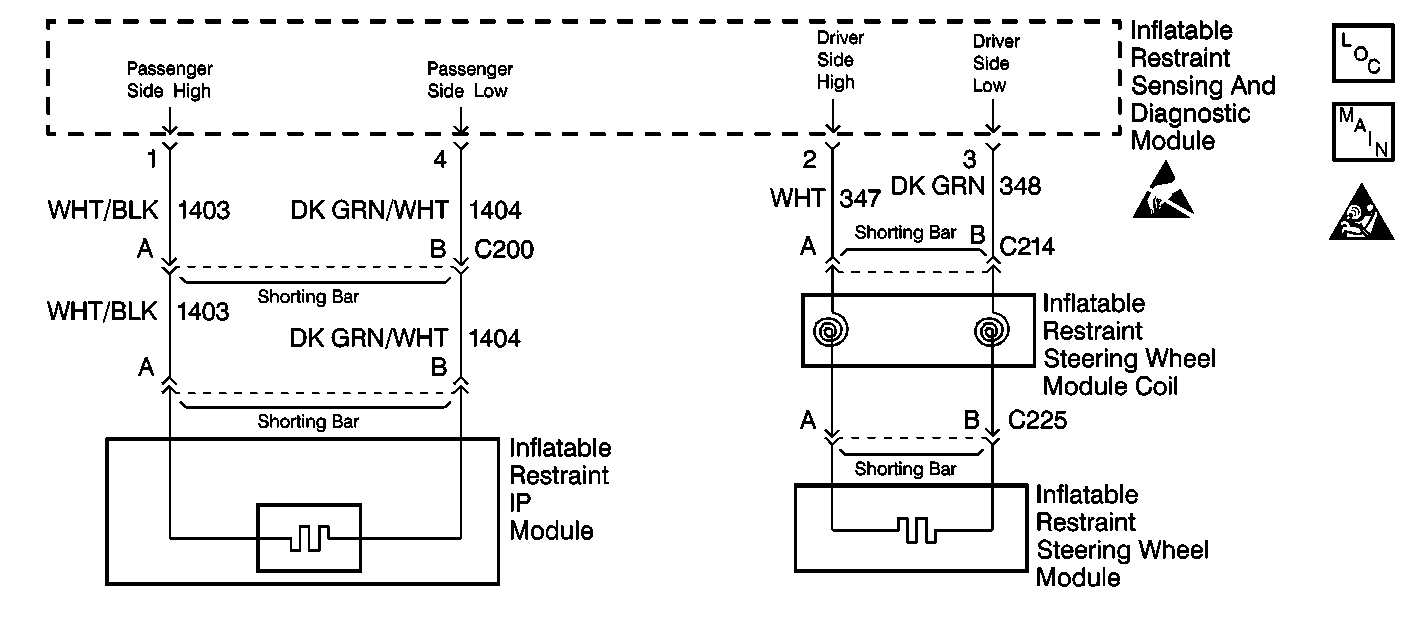
Circuit Description
When you first turn the ignition switch to the RUN position, the inflatable restraint Sensing and Diagnostic Module (SDM) performs tests to diagnose critical malfunctions within itself. Next the SDM measures IGNITION 1 and the deployment loop voltages to make sure they are within their respective normal voltage ranges. Then the SDM proceeds with the RESISTANCE MEASUREMENT test. During one portion of the RESISTANCE MEASUREMENT test, the SDM does the following:
| • | Grounds the PASSENGER SIDE LOW terminal 4 through an internal current sink. |
| • | Connects the PASSENGER SIDE HIGH terminal 1 to an internal constant current source. This current produces proportional voltage drops in the deployment loop. |
| • | Measures the voltage difference between PASSENGER SIDE HIGH and PASSENGER SIDE LOW. |
| • | Calculates the resistance of the passenger deployment loop using the measured voltage. |
Conditions for Setting the DTC
| • | The driver and passenger deployment loops are not open. |
| • | The driver and passenger deployment loops are not shorted to voltage. |
| • | The passenger deployment loop is not shorted to ground. |
| • | The passenger deployment loop resistance is less than 1.4 ohms. The passenger deployment loop consists of the following components: |
| - | Inflatable restraint IP module. |
| - | Harness wiring of CKT 1403. |
| - | Harness wiring of CKT 1404. |
| - | Connector terminal contact. |
The RESISTANCE MEASUREMENT test checks for this malfunction. This test only occurs once each ignition cycle when IGNITION 1 is within the normal operating voltage range.
Action Taken When the DTC Sets
| • | The SDM sets a diagnostic trouble code. |
| • | The SDM turns ON the AIR BAG warning lamp. |
Conditions for Clearing the DTC
| • | Current DTC |
| The resistance of the passenger deployment loop is more than 1.4 ohm and the ignition switch is cycled. |
| • | History DTC |
| - | You issue a scan tool CLEAR CODES command. |
| - | Once 250 malfunction free ignition cycles have occurred. |
When you issue a scan tool CLEAR CODES command and the malfunction is still present, the DTC will not reappear until the next ignition cycle.
Diagnostic Aids
The following can cause an intermittent condition:
| • | A short circuit between CKT 1403 and CKT 347. |
| • | A short circuit between CKT 1403 and CKT 348. |
| • | A short circuit between CKT 1403 and CKT 1404. |
| • | A malfunctioning shorting bar on the inflatable restraint IP module connector. |
The diagnostic table directs the technician to note the entry value of PASSENGER RESISTANCE. Comparing the value of PASSENGER RESISTANCE over multiple ignition cycles can be helpful in determining if an intermittent condition exists.
When measurements are requested in this table, use the J 39200 DMM with the correct terminal adapter from the J 35616 Connector Test Adapter Kit. When an inspection for proper connection is requested, refer to Testing for Electrical Intermittents in Wiring Systems. When a wire, connector or terminal repair is requested, use the J-38125 Terminal Repair Kit and refer to Wiring Repairs in Wiring Systems.
Test Description
The numbers below refer to the step numbers on the diagnostic table:
-
This test determines the deployment loop resistance measured by the inflatable restraint sensing and diagnostic module (SDM).
-
This test isolates the malfunction to one side of the inflatable restraint IP module yellow 2-way connector.
-
This test inspects for a short from CKTs 1403 to 1404.
-
This test inspects for a short from CKTs 1403 to 348.
Step | Action | Value(s) | Yes | No |
|---|---|---|---|---|
1 | Was the SIR Diagnostic System Check performed? | -- | ||
Is DTC B1022 also present? | -- | |||
3 |
Is the repair complete? | -- | -- | |
4 |
Is PASSENGER RESISTANCE less than the specified value? | 1.4 ohms | ||
5 |
Is the repair complete? | -- | -- | |
Is PASSENGER RESISTANCE less than the specified value? | 1.4 ohms | |||
7 |
Is the repair complete? | -- | -- | |
Is the resistance less than the specified value? | OL | |||
9 |
Is the repair complete? | -- | -- | |
Measure the resistance from the SDM harness connector terminal 1 to terminal 3. Is the resistance less than the specified value? | OL | |||
11 | Repair the short from CKT 1403 to CKT 348. Is the repair complete? | -- | -- | |
12 |
Have all the SIR components been reconnected and properly mounted? | -- | -- | |
13 | Clear the SIR DTCs. Have all the DTCs been cleared? | -- | -- |
